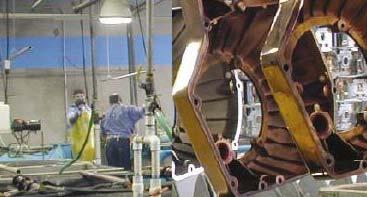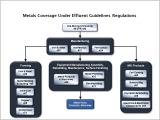Metal Finishing Effluent Guidelines
 EPA promulgated the Metal Finishing Effluent Guidelines (40 CFR Part 433) in 1983, with technical amendments in 1984 and 1986. The regulations cover wastewater discharges from a wide variety of industries performing various metal finishing operations. About 44,000 facilities perform various metal finishing operations and discharge process wastewater directly to surface waters or indirectly to surface waters through POTWs. The Metal Finishing Effluent Guidelines are incorporated into NPDES permits for direct dischargers, and permits or other control mechanisms for indirect dischargers (see Pretreatment Program).
EPA promulgated the Metal Finishing Effluent Guidelines (40 CFR Part 433) in 1983, with technical amendments in 1984 and 1986. The regulations cover wastewater discharges from a wide variety of industries performing various metal finishing operations. About 44,000 facilities perform various metal finishing operations and discharge process wastewater directly to surface waters or indirectly to surface waters through POTWs. The Metal Finishing Effluent Guidelines are incorporated into NPDES permits for direct dischargers, and permits or other control mechanisms for indirect dischargers (see Pretreatment Program).- What is Metal Finishing?
- Facilities Covered
- Related Categories
- Preliminary Category Review — 2018
- Guidance and Background Documents
- Rulemaking History
- Additional Information
What is Metal Finishing?
Metal finishing is the process of changing the surface of an object, for the purpose of improving its appearance and/or durability. Metal finishing is related to electroplating, which is the production of a thin surface coating of the metal upon another by electrodeposition.
Facilities Covered
- Fabricated Metal Products, except Machinery and Transportation
- Machinery, except Electrical
- Electrical and Electronic Machinery, Equipment and Supplies
- Transportation Equipment
- Measuring, Analyzing and Controlling Instruments: Photograph; Optical Goods; Watches and Clocks
- Miscellaneous Manufacturing Industries
Core Operations
- electroplating (exceptions: see Related Categories)
- electroless plating
- anodizing
- coating (phosphating, chromating, and coloring)
- chemical etching and milling
- printed circuit board manufacture (exceptions: see Related Categories)
If a plant performs any of those 6 operations, then discharges from the 46 operations listed in 40 CFR 433.10(a) are covered by the Part 433 standards.
Related Categories
- "job shop" electroplaters (those which in a calendar year do not own more than 50 percent of the material undergoing metal finishing), and
- independent printed circuit board manufacturers,
- which are located at indirect discharger facilities, and
- that were in operation before July 15, 1983.
- Aluminum Forming (40 CFR Part 467)
- Battery Manufacturing (40 CFR Part 461)
- Coil Coating (40 CFR Part 465)
- Copper Forming (40 CFR Part 468)
- Electrical and Electronic Components (40 CFR Part 469)
- Iron and Steel Manufacturing (40 CFR Part 420)
- Metal Molding and Casting (Foundries) (40 CFR Part 464)
- Nonferrous Metals Forming and Metal Powders (40 CFR Part 471)
- Nonferrous Metals Manufacturing (40 CFR Part 421)
- Plastics Molding and Forming (40 CFR Part 463)
- Porcelain Enameling (40 CFR Part 466)
Preliminary Category Review — 2018
EPA completed a preliminary review of the Metal Finishing category in 2018. In the review, the Agency collected data to understand the current state of the industry, including its economic condition, the wastewater pollutants discharged, and the wastewater treatment technologies and management techniques used to control these discharges, including zero discharge. Based on its observations, EPA concluded that further regulation of the Metal Finishing category is not warranted at this time. Questions about the applicability of the existing Metal Finishing Effluent Guidelines to current metal finishing operations persist and EPA will focus its efforts going forward on resolving them.
Guidance and Background Documents
- Download the publications
- Coverage for Zirconization™ process (Memo, April 2016)
- "Chemical Etching" Metal Finishing Option (Memo, June 2004)
- Regulatory Determination for the "PreKote" Surface Preparation Process (April 2003)
- Misuse of Sodium Dimethyldithiocarbamate (Memo, June 2000)
- Permitting Guidance for Semiconductor Manufacturing Facilities (Memo, April 1998)
- Guidance Manual for Implementing Total Toxic Organics (TTO) Pretreatment Standards (1985)
- Guidance Manual for Electroplating and Metal Finishing Pretreatment Standards (1984)
Rulemaking History
- Download the publications
- Technical Amendment (November 7, 1986)
- Correction (October 3, 1983)
- Interpretation and Correction (September 26, 1983)
- Technical Amendment (September 15, 1983)
- Final Rule: Metal Finishing and Electroplating Categories (July 15, 1983)
- Development Document (1983)
Industry description, wastewater characterization, treatment technologies, regulatory compliance cost estimates and pollutant loadings for the final rule
- Development Document (1983)
- Proposed Rule: Metal Finishing and Electroplating Categories (August 31, 1982)
Additional Information
For additional information regarding Metal Finishing Effluent Guidelines, please contact Ahmar Siddiqui (siddiqui.ahmar@epa.gov) or 202-566-1044.

